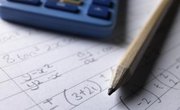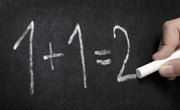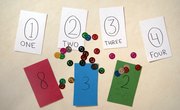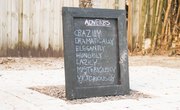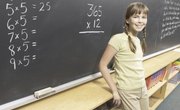Teaching numbers to ESL students is not an easy task. Some students will grasp the concepts very quickly, whereas others will have endless difficulties just getting the basics. For your students to get the most out of your lessons, you'll need to approach the subject from a variety of perspectives, since a single-minded approach will not necessarily work for all of your students.
Determine your students' level of familiarity with the concepts of plurality vs. singularity. Since most numerical concepts relate to plurality or singularity, prior knowledge of those concepts will reduce the confusion that your students might experience when attempting to conceptualize quantity. If your students do not understand these concepts, take some time to cover them.
Once your students have demonstrated understanding of singularity and plurality, introduce the first 11 numbers to students, 0 through 10. Write the numbers on the board and have the students count through them. At this point, it might help to give each student a number of the counting items you brought to class. Don't worry about giving each student 10 of the items. If some students have more or less than others, it will help with the lesson.
Address each number individually. Ask students to raise their hands when you name the number of items that they hold. This way, you can review in the same class period by asking questions such as, "Who had seven beans?" and address tense, possession and numbers at the same time. You can also ask the students to consider numbers abstractly. "Does anyone here own three of something?" Students can use vocabulary to name items they may not have on hand. This activity will allow you to evaluate students' speaking and listening skills.
At the end of class, distribute worksheets that require students to identify numbers, either by name or by quantity of items. Higher numbers can be introduced via these worksheets and then discussed in class, or the worksheets can be used to review the day's lesson. Since the worksheets are teacher created, they can be adapted for either use. Consider including homework that requires the student to write sentences that answer questions related to the numbers learned in class, or a short story of a few sentences or paragraphs that involve the numbers learned in class. Students can be asked to read their stories in the next class meeting for extra listening and speaking practice. The teacher can also evaluate student comprehension of the concepts. The worksheets and assignments will allow you to evaluate the students' reading and writing skills.
When the students have grasped the fundamentals of the numbers through 10 or 20, learning additional number sets won't be much of a problem. Younger students can learn to conceptualize larger numbers through grouping (e.g., "100 is 10 groups of 10"). Older students can learn larger numbers through more abstract examples, such as the costs of various products. You can also teach students to recognize large numbers by number of digits (e.g., "#### has four digits, which means it represents a value of thousands").
As your students grow familiar with numbers written as digits, consider notating them as words, to improve reading and grammar skills.
Tip
Adults may already know numbers; use a test or quiz to determine their familiarity with the concept. It may feel patronizing to adult ESL students if you treat numbers as being too elementary. For those who subscribe to Gardner's Theory of Multiple Intelligences, number-teaching activities lend themselves especially well to allowing the teacher to develop and evaluate classroom activities that involve the proposed intelligences.
Warning
Do not get sidetracked when teaching numbers. Allowing some mathematics into the lesson is alright, but avoid creating mathematics-centered lesson plans. Remember that the goal of your class is to improve students' English skills.
Related Articles
Tips
- Adults may already know numbers; use a test or quiz to determine their familiarity with the concept. It may feel patronizing to adult ESL students if you treat numbers as being too elementary. For those who subscribe to Gardner's Theory of Multiple Intelligences, number-teaching activities lend themselves especially well to allowing the teacher to develop and evaluate classroom activities that involve the proposed intelligences.
Warnings
- Do not get sidetracked when teaching numbers. Allowing some mathematics into the lesson is alright, but avoid creating mathematics-centered lesson plans. Remember that the goal of your class is to improve students' English skills.
Writer Bio
Mike Arneson is an adjunct professor of English. He's been a professional writer since 2003 and was chief editor of his English department's student literary magazine, "Notations." His other online publications include procedurals for various websites. He has a Bachelor of Science in professional writing and a Master of Arts in TESOL.


